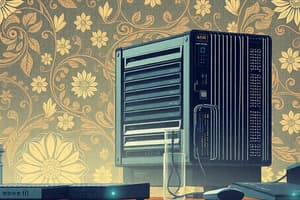Podcast
Questions and Answers
Charles Babbage created both the Analytical Engine and the:
Charles Babbage created both the Analytical Engine and the:
- Card Reader Engine
- Digital Processing Engine
- Internal Combustion Engine
- Difference Engine (correct)
This person played a key role in formulating the notion of programming the Analytical Engine to perform different functions.
This person played a key role in formulating the notion of programming the Analytical Engine to perform different functions.
- Herman Hollerith
- Ada Byron (correct)
- Blaise Pascal
- Lord Byron
Hexadecimal numbers use these symbols:
Hexadecimal numbers use these symbols:
- 0 through 15
- 1 through 9 and A through G
- 0 through 9 and A through F (correct)
- 0 through 10 and A through E
Using an 8-bit 2’s complement representation, the decimal integer –101 has a bit pattern
Using an 8-bit 2’s complement representation, the decimal integer –101 has a bit pattern
The decimal equivalent of 01101010 interpreted as a 2’s complement number is
The decimal equivalent of 01101010 interpreted as a 2’s complement number is
Which of the following is an example of a non-volatile memory?
Which of the following is an example of a non-volatile memory?
In the context of computer architecture, what does CPU stand for?
In the context of computer architecture, what does CPU stand for?
Which of the following is an example of a high-level programming language?
Which of the following is an example of a high-level programming language?
What is the purpose of an operating system?
What is the purpose of an operating system?
What does HTTP stand for in relation to the internet?
What does HTTP stand for in relation to the internet?
Flashcards are hidden until you start studying
Study Notes
Computer History and Programming
- Charles Babbage invented the Analytical Engine and also conceptualized the Difference Engine.
- Ada Lovelace is credited with formulating the concept of programming the Analytical Engine to execute various tasks.
Number Systems
- Hexadecimal numbers utilize digits and letters: 0-9 and A-F.
- In an 8-bit 2’s complement representation, the decimal integer -101 is represented as the bit pattern 10011101.
- The decimal equivalent of the bit pattern 01101010 treated as a 2’s complement number is 106.
Memory Types
- Non-volatile memory retains data even when the power is turned off; examples include flash memory and ROM.
Computer Architecture
- CPU stands for Central Processing Unit, the primary component responsible for interpreting and executing instructions in a computer.
Programming Languages
- High-level programming languages are designed to be easy for humans to read and write; examples include Python, Java, and C++.
Operating Systems
- The purpose of an operating system is to manage computer hardware and software resources and provide services for computer programs.
Internet Terminology
- HTTP stands for Hypertext Transfer Protocol, a protocol used for transmitting hypertext via the internet.
Studying That Suits You
Use AI to generate personalized quizzes and flashcards to suit your learning preferences.




